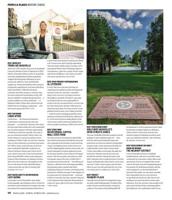It’s early yet, but initial plans to build a 24-acre park near downtown on the banks of the Cumberland River are cause for joy among some and concern for others.
Parks and recreation advocates, especially those affiliated with Nashville’s rowing scene, are enthusiastic about plans for the site, which would be named Wharf Park. It sits below Rolling Mill Hill, partially under the Silliman Evans Bridge, and could eventually be home to a multi-use recreation facility and other amenities.
But homelessness advocates and those who live at the undeveloped site are worried unhoused residents could be pushed out of yet another property, after being expelled from or pressured to leave several other areas in recent years.
Kayla Marie Phillips, who attended a Tuesday public event about the project at Napier Community Center, said she’s lived at the property, along with an estimated 150 to 200 other people, for about four months.
“People are down there, and they’re struggling to survive,” Phillips said. “Doing this, it’s going to cause them to start all over again. It's going to cause them to lose hope. We’ve gotten kicked out of everywhere else. Where are we going to go?”
Tim Netsch, assistant director for planning at Metro Parks, said the agency is aware of the large population of people living on the site and is conducting ongoing meetings with the city’s homeless impact division and other service providers “to address the issue.” This far out from completion of the new park, which would take at least two years, there’s no answer yet about how to accommodate the residents, Netsch said.
The projected two-year timeline could be optimistic. There’s no dedicated funding yet for construction of the park, and designers are still in the process of gathering community input and determining what should go on the site. Netsch said the city will close on purchasing the last piece of the property in about a month.
“There's so much potential on this site,” he said. “It has a character that is unique in downtown Nashville. It has a mature riverfront forest, there are beautiful bluffs, and it presents really unique opportunities to create a great new park space close to downtown.”
Possible issues facing park planners include flooding, leftover industrial contamination, some steep terrain and — given the interstate’s location — connections to nearby neighborhoods and other city greenways and parks.
In addition to a potential recreation facility to house things like a rowing program, Netsch said the park could be home to playgrounds, basketball courts, tennis courts and other amenities in “an area that’s otherwise underserved with some of those features.”
Nashville rowers have been seeking a facility on the Cumberland River for a decade or more. Currently, the Nashville Rowing Club stores its equipment outdoors at the Hamilton Creek Marina on Percy Priest Lake.
In addition to the convenience of an indoor facility, rowing club board member Henry Trost said a dedicated facility at a new Wharf Park would allow them to open up their junior programs to kids from Metro Schools who rely on public transportation, which is not available at Hamilton Creek. Currently, their junior programs are largely made up of students from private schools and Williamson County.
“We can’t get Nashville public schools involved,” he said. “With a downtown location, we’d have access to all of the public schools. We could offer rowing to Metro Public Schools as an alternative athletic endeavor. It would open it up to a lot bigger slice [of students].”
Metro Councilmember Freddie O’Connell, whose District 19 includes the proposed park, said that funding concerns made him pessimistic that a park would be completed by the time his term is up in 2023.
He also echoed concerns about the residents living on the site and pointed to the imminent commencement of construction of permanent supportive housing for unhoused residents. However, that project has seen delays and would not offer enough beds to cover the estimated number of people reportedly living on the property.
“I am going to continue to advocate for housing, but I don’t think you say we can’t touch this public land because there are some people here,” he said. “Affordable housing is rarely affordable to people who are currently unhoused. I’m eager to see what the next step is.
“It’s a really interesting piece of land. It’s open space like we don’t have in most other parts of the city.”





